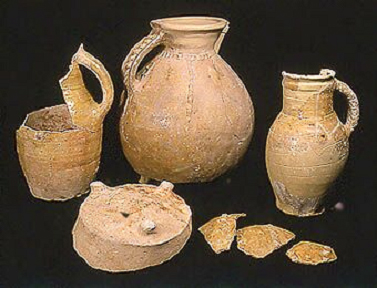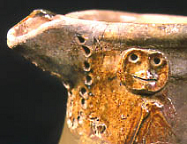|
The late 12th to mid
13th centuries
The
late 12th - mid 13th century well assemblages show a marked trend
towards regional imports of tablewares. Two are particularly prominent
-- Nuneaton Ware (OXAH) from Warwickshire, a white fabric with a distinctive
light yellow glaze; and Ashampstead Ware (OXAG) from Berkshire, a red
iron-rich fabric that when coated with a colourless lead glaze fires to
a clear orange glaze, with a white slip decoration. These must surely
have stood out in striking contrast to the predominantly green glazed
wares of the locally produced Brill/Boarstall tradition from central Buckinghamshire.
Wells
2 and 14, where the Nuneaton Ware is the most common fabric, lie in adjacent
tenements behind Buildings 41-2, and Acland House. This tradition
dispays a variety of forms -- shoulder jug, tripod pitcher, baluster,
rounded and ovoid jugs -- which, interestingly, are not reflected in these
assemblages in the Brill/Boarstall tradition until the late 13th
century -- although we know that Brill/Boarstall had a diverse range of
forms available (Mellor 1994,114).
The
occupants of these two tenements may indeed have made an individual choice
in selecting light yellow glazed tablewares in a variety of forms -- perhaps
to simply brighten their table in a dark room or to deliberately distinguish
themselves from their neighbours (see Fig.6).
In many parts of western Europe the major regional and long distance imports
are whitewares where they are much sought after for finewares (Mellor
2004, pers.com). Such
selective choice implies both a disposable income for such purchases and
an available market from which to buy them. It is particularly apparent
in Well 2, the earliest well group chronologically, where a diversity
of jug capacity is also indicated -- a point discussed later.

Fig.6:
Well 2 assemblage shows a large tripod pitcher (Oxford Medieval Ware),
together with two ovoid jugs and the base of a second tripod pitcher --
all sport the same light yellow glaze.
Continental imported wares are absent
from these assemblages, although the French influence can be seen by the
late 13th century in the parrot beak bridge-spouted jugs of
Well 9 (see Fig.7), a fashion which Hurst (1962/3, 151) argued may have
originated through the wine trade.

Fig.7: From Well 9. Shows the detail of a parrot beak bridge-spouted jug, also with an applied face mask decoration below the rim.
From the
mid 13th century the local Buckinghamshire Brill/Boarstall fineware takes
over as the predominant fabric and regional imports become less
apparent, which reflects a common trend across the county. The exception
is the East Wiltshire coarseware (OXAQ), which produced principally cooking
and storage vessels, and continues to appear in the early 14th
century assemblages in Well 10 and Pit G when it was the only coarseware
supplied in Oxford (Mellor 1994, 106). The glazes on finewares change
from the monochrome light yellow and greens
of the late 12th to mid 13th century seen in Wells
1,2, 14 and 23, to the highly decorated polychrome jugs which appear in
the Brill/Boarstall wares of Well 9.
|